Calf muscle strain: Cause, symptoms, Diagnosis, Treatment, Exercise
Table of Contents
What is calf muscle strain?
- A calf muscle strain is caused by overstretching or tearing any of the soules and gastrocnemius muscles of the calf. It can be suddenly, or develop slow over time. stepping, climbing stairs, or running can be painful, difficult, or hopeless with a calf strain.
- The calf muscles area unit in your lower leg behind your tibia and extend from the very cheap of your thigh right down to your heel.
- They assist you in flexing and bending your foot, articulation plans, and knee.
- A calf strain can cause pain and forestall you from running, jumping, and doing different activities.
- A severely force calf muscle could find you in partial or complete tears. A torn calf muscle would possibly need surgery.
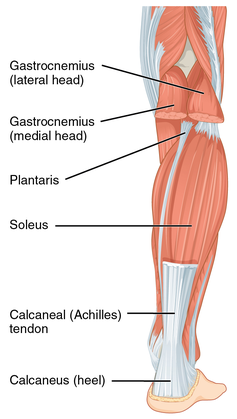
Is a strain like a sprain?
- A calf strain isn’t a sprain. Strains area unit injuries to muscles or tendons (tissues that attach muscles to bones). Sprains are injuries to ligaments (tissue that connects bones or cartilages or holds a joint along
Where is the calf muscle located?
- Calf muscle consists of two main muscles — the gastrocnemius muscle and additionally the soleus muscle. as a result of these two muscles shutting more than heel and fixing to the sinew, the gastrocnemius and soleus muscles are mutually big muscles with two sections.
- In addition of those two large muscles, a little muscle called the plantaris runs between the gastrocnemius and soleus muscle down the length of the lower leg. these three muscles are the triceps surae. however, not everyone contains a plantaris muscle. about 100 percent of individuals solely have 2 larger muscles.
It is composed of 3 muscles:
Gastrocnemius muscle
gastrocnemius – in conjunction with soleus muscle, provides primarily plantar flexion of the knee joint and flexion at the ginglymoid joint. plantar flexion provides the knee joint force throughout gait. though it spans over two joints, the gastrocnemius muscle isn’t able to exert its most power on each joint at the same time. If the knee is flexed, the gastrocnemius muscle cannot produce most power at the ankle joint and the other way around.
Origin: proximal to body part surfaces of aspect condyle of the leg bone and medial condyle of the femur
Insertion: tendo calcaneus (Achilles tendon) intomid-posterior os tarsi fibular
Nerve: tibial nerve from the sciatic, nerve roots S1 – S2
Actions: plantar flexes foot, flexes knee
Antagonist: Tibialis anterior muscle
Soleus muscle
soleus – is found at a lower place the gastrocnemius within the superficial posterior compartment of the lower leg. It is main performance is area flexion of the ankle joint and helps the shinbone on the calcaneus limiting forward sway.
Origin: Fibula, medial border of tibia (soleal line)
Insertion: Tendo os tarsi fibular
Nerve: Tibial nerve, nerve roots L5 – S2
Actions: Plantar flexion
Antagonist:Tibialis anterior
Plantaris muscle
plantaris – is located within the posterosuperficial compartment of the calf. Functionally, plantaris isn’t a serious contributor and acts with gastrocnemius muscle as each a flexor muscle of the knee and a plantar flexor of the ankle joint.
Origin: Lateral supracondylar ridge of the femur on top of the lateral head of gastrocnemius muscle
Insertion: Tendo calcaneus (medial aspect, deep to gastrocnemius muscle connective tissue
Nerve: tibial nerve from anterior rami of S1-S2
Actions: Plantar flexes the foot and flexes the knee
Antagonist: Tibialis anterior muscle
Who gets calf muscle strain?
- Anyone can get a forced calf muscle. but these strains square measure are common in athletes who perform several stop-and-go movements with quick bursts of speed. Sprinters, association football players, players, and court game players are at risk of forced calf muscles. typically the injury is termed “tennis leg.”
What is the cause of calf muscle strain?
An acute calf muscle strain is once muscle tears quickly and unexpectedly. muscle tears will occur either from injuries or trauma. this will result to:
- Not warming up properly before physical activity
- Poor flexibility
- Poor conditioning
- Overexertion and fatigue
- calf muscle Weakness
Acute calf muscle strain:
Slip body, jump, run, throw something, raise something heavy, lift something while in you are in an ungainly position.
Chronic calf muscle strain:
Sports like row, tennis, golf, or baseball, poor posture, holding your back or neck in an ungainly position for long periods of your time, like after you work at a desk
Overuse:
- Repetition of a similar movement, whether or not at work or during an associate activity like taking part in sports — will cause overuse syndrome.
- Don’t stretch or warm up before exercise: Stretching before exercise step by step will increase how much stress you place on your muscles.
- A lack of flexibility: If you’re not much flexible, your calf muscles (and the fibers in them) are tighter, which makes them additional susceptible to strains.
Calf strains classified into three grades
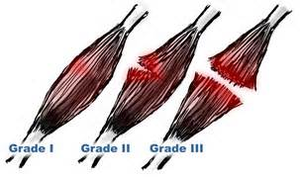
Grade 1: the type of strain that happens once a stretch causes very few micro-tears among the muscle fibers. could also be ready to continue an activity. without pain or with gentle discomfort. post activity tightness and aching, Full recovery take regarding the period of your time.
average time to come back to sport:10-12 days
sing-pain on unilateral calf raise or hop
Grade 2: This strain involves a partial tear of the muscle fibers. you may get to limit activity, but full recovery takes around five to eight weeks.
average time to come sport:16-21 days
sing-pain with active plantar flexion, pain and weakness with resisted plantar flexion, loss of flexion,
Grade 3: Usually this can be often the foremost severe and immediate pain in the calf, and involves a whole tear or rupture of the affected muscle fibers. Full recovery can take three to four months and, in some instances, surgery may even be needed.
average time to come sport: 6 months once surgery
sing-inability to contract calf muscle may have the palpable defect, Thomson’s test positive
Signs and symptoms
rely on the open severity of the injury.
in delicate calf muscle strain could feel slightly stiff, however still versatile enough to be used.
- Unexpected pain in the back of your lower leg, like someone demurred your calf.
- Pain or tenderness over the calf muscle
- Snapping or popping sensation in your calf
- Swelling and bruising in your calf muscle.
- Limited movement of a calf muscle
- Calf muscle spasms
- Muscle weakness
- Muscle stiffness
There risk factors for forcing calf muscles include:
Age: individuals over forty could also be additional possible to induce strains throughout physical activity.
Sex: Some studies recommend that men square measure additional doubtless to urge calf muscle injuries.
Lack of conditioning: It’s important to heat up and stretch before physical activity and condition your muscles before the beginning of a sports season.
Muscle quality: individuals with tight or short calf muscles have a higher risk of calf strains.
Differential Diagnosis
- Medial leg bone stress syndrome
- Plantar fasciopathy
- Ankle Joint sprain
- Achilles tendinopathy
- Leg injuries related to sports with similar symptoms and treatment as a calf strain are mentioned below.
- Popliteal Artery entrapment Syndrome (PAES)
- Chronic exertional compartment syndrome (CECS)
Assessment
Subjective assessment
- history with associated symptoms
- mechanism of injury:
- inciting trauma-direction and magnitude of injury force
- repetitive trauma-faulty postural related injuries
Objective assessment
- Observation of the foot and ankle in supine and standing position
- Ankle Active range of motion
- Ankle Passive range of motion
- Resisted strength testing of the ankle and foot
- Knee Active range of motion and manual muscle testing
On objective assessment, there will be:
- muscle Tenderness- to touch at the point of injury
- Swelling
- Bruising may appear within hours or days
- Stretching of the muscle will reproduce pain
- Pain on resisted plantar flexion
Treatment:
Medical Treatment
Calf muscle strains infrequently require surgery still may be necessary for a complete rupture.
- FOR immediate
- Nonsurgical, Conservative treatment Most muscle strains don’t demand surgery if the muscle is completely damaged doctors suggest surgery If there’s a partial tear also the athlete can return when they’re effortless and have normal strength and movement. This generally occurs following anywhere from few weeks to few months of significant treatment.When the muscle is completely damaged, the athlete may profit from surgical repair
- Pain reliving medicine mainly Non-Steroidal Anti-Inflammatory Drugs (NSAIDs) — during the first 48 hours after a muscle strain. Acetaminophen (Tylenol) and others can be helpful for pain relief during this period.
- A physiotherapist can help you to increase the strength and stability of the injured joint or limb. Your doctor may suggest that you stabilize the calf with a brace or splint. For some calf muscle inures, some calf muscle sprint surgery may be called.
To prevent swelling and pain as first aid by following RICE principal:
R- rest
I- ice for cooling
C- compression: tapping and splinting
E- elevation
the R.I.C.E approach

- Rest. keep away form activities that cause pain, swelling, or discomfort. don’t avoid all physical activity.
- Ice. although you’re seeking medical facilities, ice the world quickly. Use Associate in Nursing associate ice pack or slush tub of ice and water for fifteen to twenty minutes each time and repeat every two to three hours. In contrast, you are awake for the first few days once the injury.
- Compression. to help stop swelling, compress the world with an associate degree bandage until the swelling stops. don’t wrap it too tightly otherwise, you would possibly hinder circulation. Begin wrapping at the highest farthest from your heart. Loosen the wrap if the pain will increase, space|the world|the realm} becomes numb or swelling goes on below the wrapped space.
- Elevation. Elevate the leg on high of your heart’s extent, significantly at night time, that allows gravity to help reduce swelling.
PHYSIOTHERAPY TREATMENT:
The goal of physiotherapy treatment are:
- Relieve calf muscle pain
- Reduce muscle swelling
- Increases calf muscle strengths.
- improve full mobility of the ligament and corresponding joint
- restore patient’s confidence
- restore patients’ full functional activity
Physiotherapy Treatment and Exercise:
calf muscle strain treatment
- physiotherapy rehabilitation can be started after 48 hours of injury, For the first few days give electric modality give to relieve swelling and pain
Ultrasound
- ultrasound has been used about tissue healing
- increases blood circulation and mobility.
- to reduce swelling and pa
Cryotherapy
- Inflammation and swelling can be reduced by applying cryotherapy in form of ice packs, and cold water baths to the affected area. Continuous application of cold several times a day for 15-30 minutes at a time is recommended.
TENS
- Trans cutaneous electrical nerve stimulation (TENS) may be able to help reduce pain and muscle spasms.
Calf muscle strain rehabilitation exercises
Phase one- the first week after injury
- ice application , 3 times par day
- compression
- isometric exercise: heel press
Phase two- the two and three weeks after injury
- ice appliance 15-20 min, after exercise
- start active range of motion exercises,
- rest from painful activities.
- range of motion exercise: knee flexion exercise
- knee extension
- plantar flexion
- dorsiflexion
- genital calf resisted exercise-
- no stretching exercises
Phase three-3 to 4 weeks after injury
- gentle strengthening exercises:
- knee flexion
- knee extension
- plantar flexion
- dorsiflexion
- genital pain-free calf stretching:
You can begin gently stretching your calf muscle.
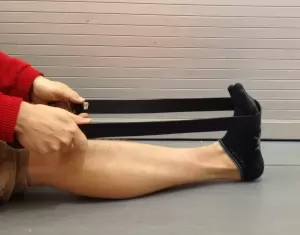
1.Towel stretch:
- Sit on a tough surface with one leg stretched ahead of you.
- Loop towel circling your toes and the of your foot and pull the towel toward your body keeping your knee straight.
- now hold this position for fifteen to thirty seconds and then relax.
- Repeat three times.
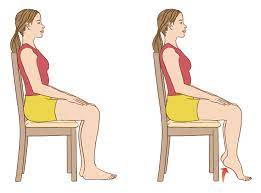
2.Seated heel Raises
- Sit in a chair with both feet on the ground.
- Pushing down through the toes, raise your heels off the ground.
- Hold this position for 10 seconds, then lower.Repeat 10 times
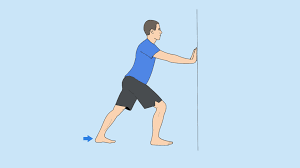
3.Standing calf stretch
- Keep both feet flat on the floor and your back knee stretch.
- Hold this position for fifteen to thirty seconds and also relax.

Do this exercises after you’ll stand on your toes while not in pain
1.Single leg balance:
- Stand with no support and arrange to balance on one leg.
- Repeat three times.
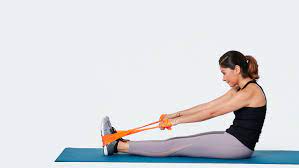
2.Resistance Band Calf Exercise:
- Wrap the band around the end of your foot and press down into the band, extending your toes and engaging the calf.
- Hold this position for three seconds, then slowly relax to the starting position.
- Perform 10 to 15 repetitions. Switch legs and repeat.
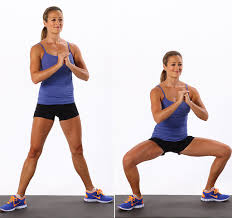
3.Full squat:
- Your hips go down below your knees.
- Perform 10 to 15 repetition
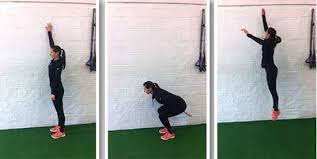
4.wall jump:
- you have to face a wall and place a piece of masking tape regarding a pair of feet higher than your head.
- After that jump up together with your arms higher than your head and take a look at the touch of the piece of tape. check that you are doing -a “spring” variety of motion and don’t land hard on your feet. improve to taking off and landing on
- A single foot. Do three sets of ten.
Other treatment
surgical treatment: maximum of muscle tear doesn’t demand surgery. A severe tear that requires a surgical form can take months or longer to heal.
Preventive measures:
- Do Regular stretching and strengthening exercises for your sports, fitness, or work exertion, as a part of an overall physical activities
- An exercise program can help to minimize your danger of muscle strains.
- Try to be in a shape to play your sport; don’t play your sport to get in shape.
- If you have a physically demanding occupation, regular exercise can help to help injuries.
- Follow a healthy diet and an exercise program to maintain a healthy weight. The overweight can put added pressure on the muscles, making muscle strains again probable to do.
- Walk at a moderate pace for 3 to 5 minutes before doing any sports or a different physical activity.
- Going this will warm up the muscles and prepare them for an increase in the intensity of the exercise.

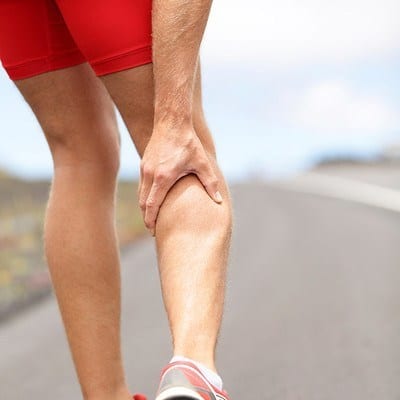
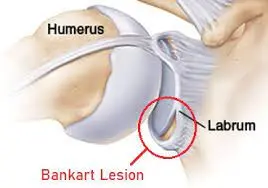
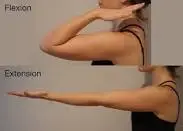

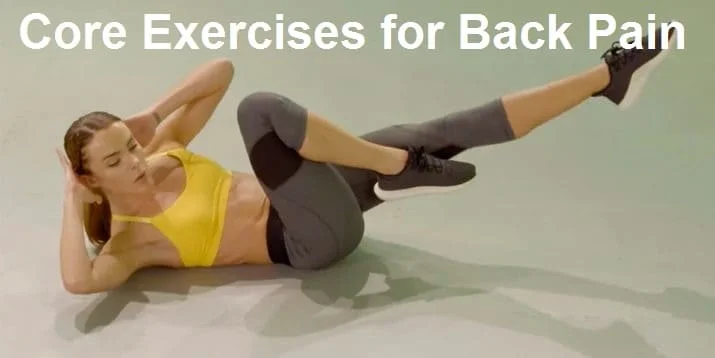
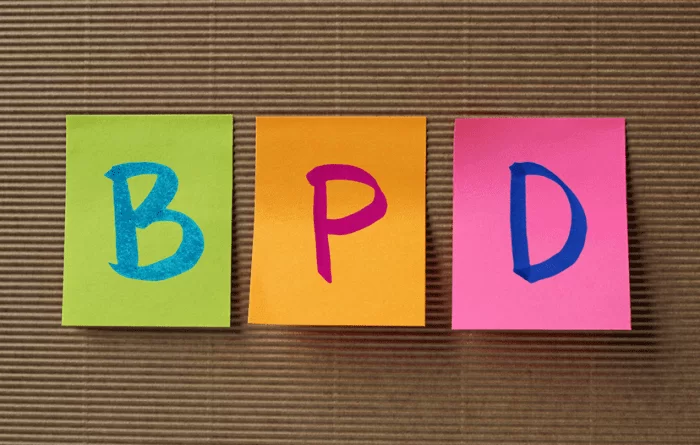
5 Comments